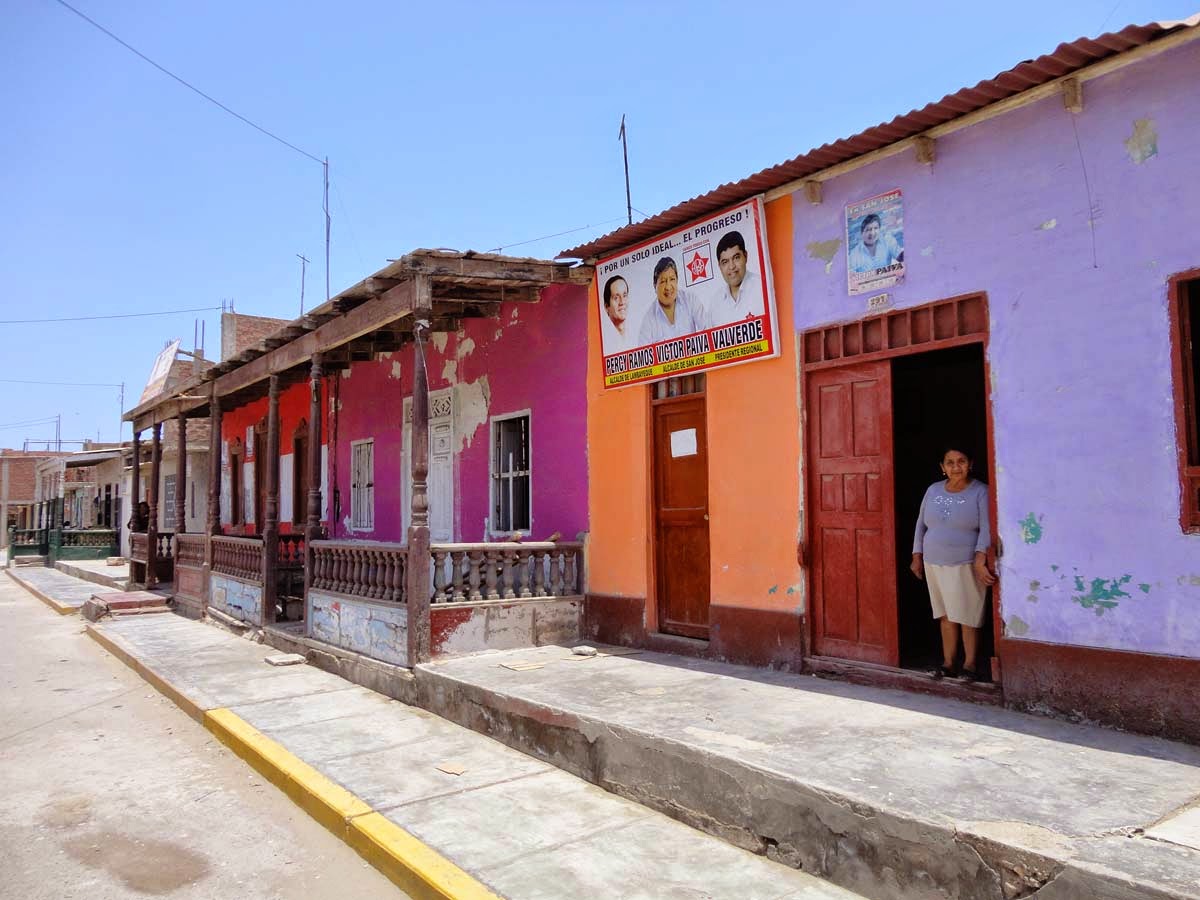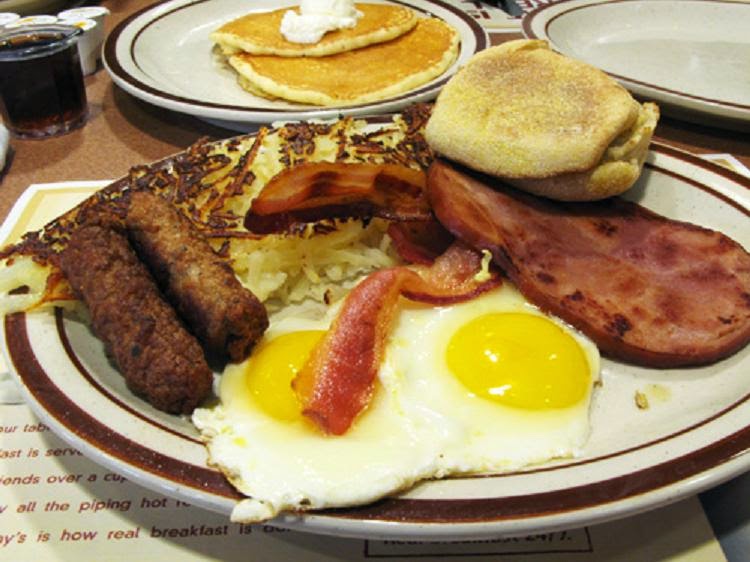[This post actually did start in the morning
and was prompted by thoughts of breakfast. I kept getting pulled away from it
before I could finish it. I had about decided to delete it before going to bed
when I thought – why not post it as a sort of ‘a day in the life of’ type
thing? Anyway, here it is.]
Even
after being in Peru for over six years I am still occasionally asked what I
miss most from the United States. There are a lot of things I miss… a ton of
things. But on Sunday mornings what I miss most is a big, greasy 8,000 calorie
American breakfast.
This
is Denny’s Grand Slam breakfast. It’s torture for me to look at this photo. I
last ate this breakfast in March in Monterey California. Bacon, eggs, ham,
sausages, hash browns, toast, pancakes and all prepared in a way that is
unmistakably American, as is the waitress who appears at the table every ten
minutes, pot in hand asking, “…more coffee, hon?”
Now,
in truth Maribel can come very close to duplicating the Grand Slam right here
in Chiclayo. The pancakes and syrup, toast, bacon and eggs (if she uses white
eggs – the brown are the norm here because they cost less but to me they have a
musty taste and odor) taste nearly identical. A thick slice of ham is difficult
to find in stores, and she has to make the hash browns from scratch, so it’s a
lot of effort but I sure appreciate it,
even if she doesn’t do the, “…more coffee, hon?”
Forget
about finding a Grand Slam breakfast in Chiclayo restaurants. A few restaurants offer what
they call ‘desayuno americana’ – American breakfast. It consists of a piece of
toast, one egg scrambled or fried (fried eggs are always burned around the
edges and the yoke is hard), and one square slice of what is referred to as ‘hamòn’ –
ham. If it wasn’t labeled ham on the menu you wouldn’t know what it was. It’s
sliced so thin that it’s nearly transparent. You could use it for window
material. If you rolled it and folded it, it would be smaller than a sugar
cube. I have had pieces of ham bigger than this stuck between my teeth after a
Denny’s breakfast. With scrambled eggs the ham is cut into ½ inch squares. You
don’t notice them so you can’t be sure if you’ve eaten them or if they’re still
on your plate. The entire breakfast, minus the toast amounts to about ¼ cup in
volume, about the same amount as the crumbs the waitress would wipe up after a
real breakfast.
We’re
looking at a trip to the States in November. I have already scoped out the
Denny’s, IHOPs and Perkins restaurants in the area we’re planning to be. Next
I’ll look at museums and other attractions. I like to do the important things
first.
##################
Another
subject we’re talking about this morning is a phone call we received yesterday
from a school director in the village of La Esperanza in the Sechura District
of the Lambayeque Region. Chiclayo is on the southern edge of the Sechura Desert… one of the driest, most
inhospitable places on earth. The village of La Esperanza sits smack in the
middle of it. We have not been there, and were surprised to learn that the
school director – Jayò, had heard about us from a school psychologist in Chiclayo.
Jayò had some interesting things to say over the phone about the village and
her school.

La
Esperanza (in the center of the photo) has about 25 families living in or near the village. There is no
electricity. Water comes from a community well. The local economy is based on raising
livestock – always an iffy business in the desert. Annual rainfall is less than 4 inches, and this year the rainy season didn’t happen, so there is no natural
food and the cost of buying feed is prohibitive. As a result many animals are
dying and the families are suffering. Parents are getting up at 5:00am to make
the two-hour trip to the city of Olmos to work, leaving their kids to fend for
themselves. That means no breakfast at home for the kids, and no lunch because
the school has no means to feed them. They eat an evening meal when their
parents return from Olmos.
Jayò’s
school is a one-room building where 20 primary students from 7 to 13 years old attend
class from 8:00am to 1:00pm. She said that when the desert wind blows hard, half
of the school’s roof “…flaps like a bird’s wing.” The classroom is where Jayò
sleeps weeknights, on the floor in a sleeping bag. On weekends she lives in
Chiclayo with her husband and daughter. She joked (I hope) about waking up with
desert coral snakes and scorpions as companions.
She
has invited us to visit the school. That would involve a two-hour combi ride to
Olmos. In Olmos, as I understand it, there is a man with a truck who makes the
two-hour daily trip to La Esperanza and other caserios IF he has sufficient
passengers. Which means that Maribel and I would also be sleeping for at least
one night on the classroom floor.
We’ve
been in caserios without electricity, but never at night, and have never slept
over. The prospect sounds both intriguing and daunting. We need to talk more
about it.
##################
It
is now Sunday afternoon, and the Green Bay Packers have just been defeated by
the Lions. It is going to be a long, long football season for us Packer fans. Maribel
and I both need to do something entertaining to pick up our spirits. Maribel
has an idea.
Perhaps
you’re thinking that playing bingo on a late Sunday afternoon at the Jesuits’
House for retired priests is not exciting. What if I told you that 1st
prize was a sack of rice? Second was a bag of sugar, and third a bottle (large)
of cooking oil. Would that get your heart pumping? We didn’t win, but it was
fun watching the faces of the winners…grins as big as if they’d hit the daily
double.
##################
It’s 10:30pm and Pittsburgh has just beaten Carolina. I like that. The
Steelers are one of the original NFL teams. I root for them unless they’re
playing the Packers. Now I can finish
this post and go to bed with a smile on my face.
 These
men graduated in 1959. That has a special significance to me because it’s
possible that on the same day they were graduating in Chiclayo I was
graduating in Milwaukee, never dreaming that 55 years later I would be watching a different graduating class march in a parade in a place called Chiclayo Peru.
These
men graduated in 1959. That has a special significance to me because it’s
possible that on the same day they were graduating in Chiclayo I was
graduating in Milwaukee, never dreaming that 55 years later I would be watching a different graduating class march in a parade in a place called Chiclayo Peru.



































